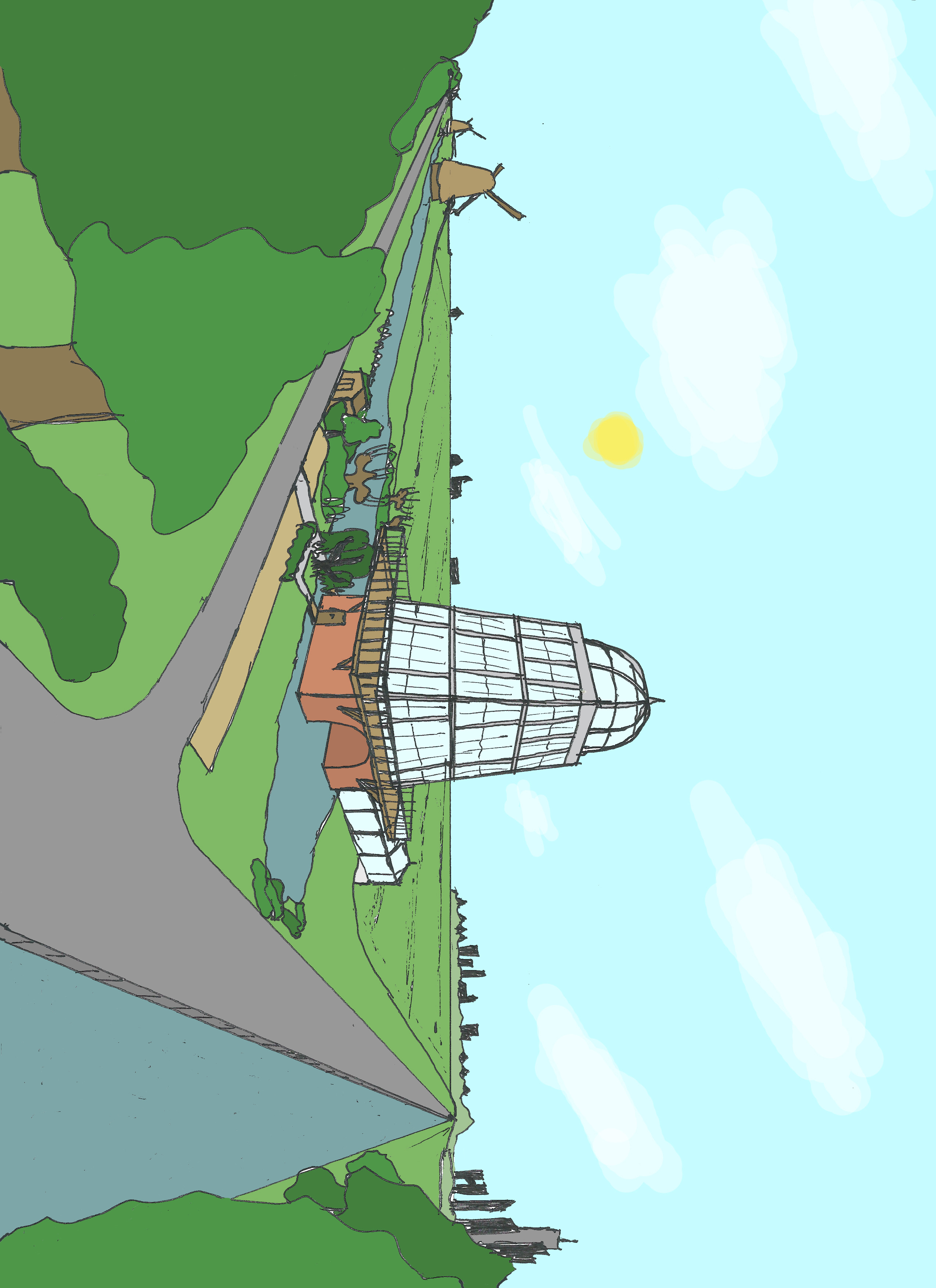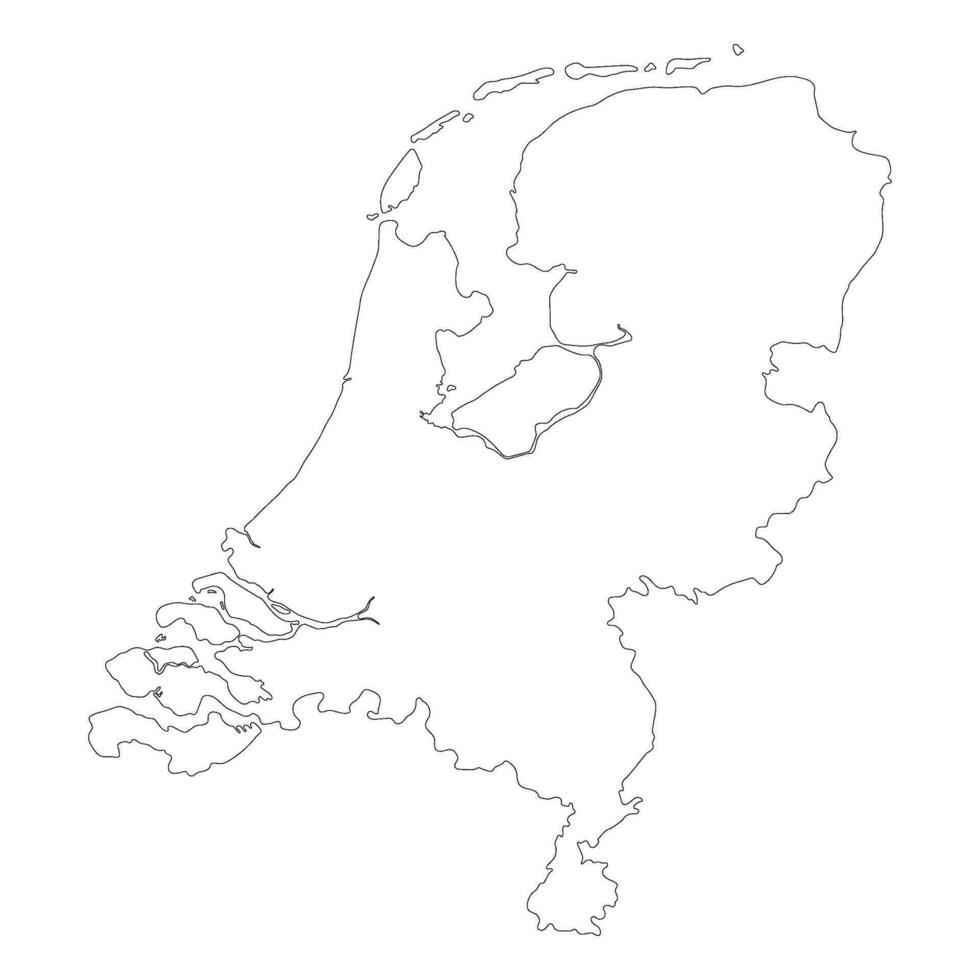🚧 Excuses!
Deze pagina is nog niet volledig vertaald. Wel is er een complete versie in het Engels.
Overview
Location
The project site is located along a country road just outside of Leidschendam, the Netherlands. This stretch of road runs through a Dutch polder landscape, on a dike system. At the site, there is an intersection with a side road, along which runs a stretch of water, and three windmills in a row. The corner between these roads is where the site is located, to use the (relative) altitude of the dike to improve the view over the surrounding landscape, for accessibility and to make use of the existing architectural presence.
Design Assignment
This assignment was the first design project I had to do for my Bachelor's program. The assignment was about creating a small, freestanding house for a park ranger, that was adapted to a given landscape. Five locations were selected for the course, of which the one described above was assigned to me. The building would have a residential program, as well as a public one, meant for education. These functions needed to be combined and assigned into one, cohesive design.
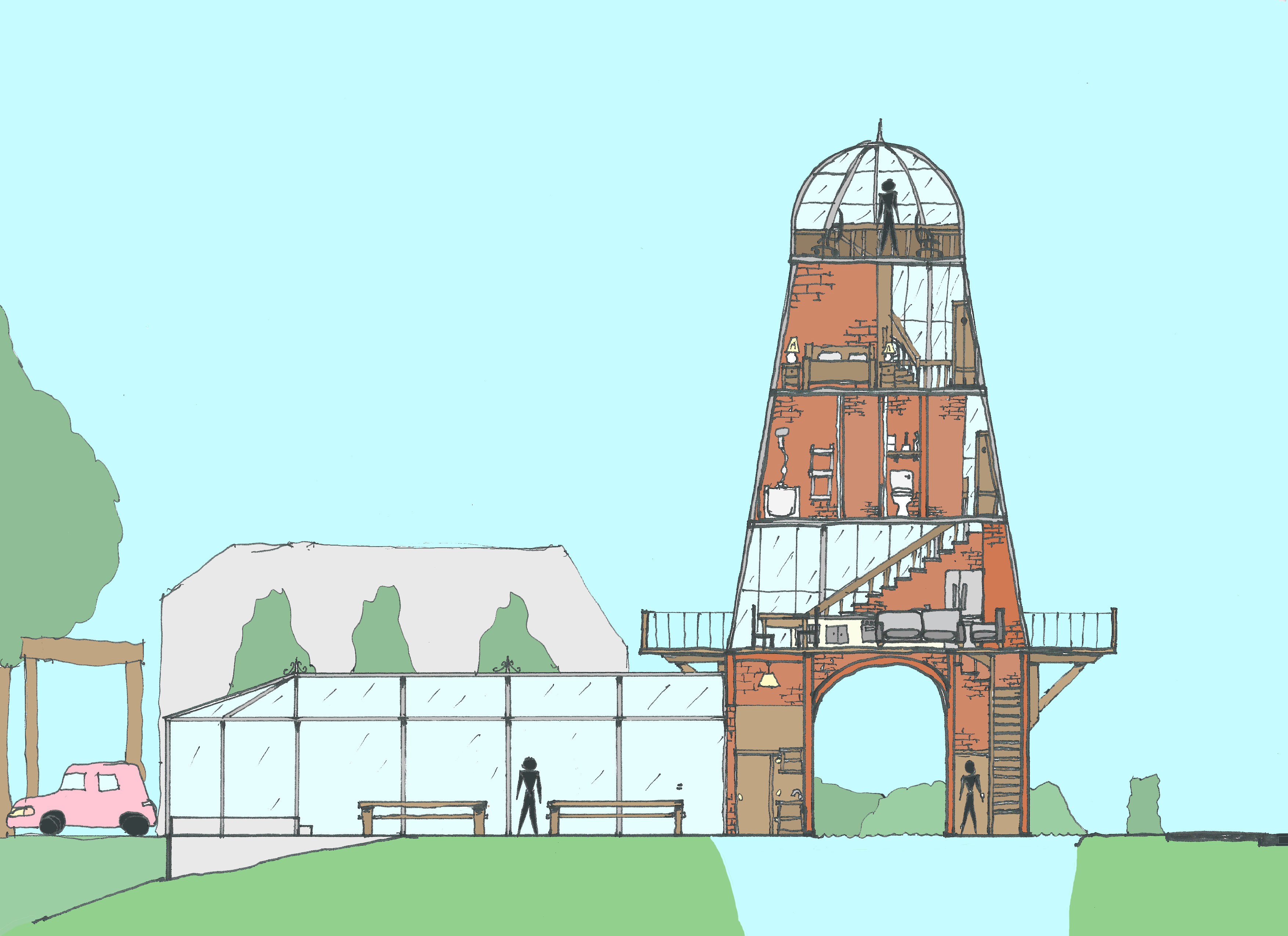
Section through the main building, visitor's center on the ground floor and residence in tower

Section through the main building, visitor's center on the ground floor and residence in tower
Park ranger's Housing & Public Visitor's Center
As the Bachelor's program's first major design project, this assignment was primarily meant to become familiar with the design process and the decisions involved along the way. This assignment focussed on turning objective research and subjective principles into an well-considered piece of Architecture, with elements of Landscape Architecture and Urbanism considered as well. The assignment covered concepts previously discussed in theory-based courses: concepts of space/void, place, public/private, context, and function. During the course, a design had to be developed for a building that would house a public park & educational center, as well as a private residence for the park ranger. The focus was on integrating these concepts with a given program, and applying theory previously learned.
My design put particular emphasis on the role of public and private space, and how to maintain maximum views outward while reducing potential viewing inwards. Additional attention was given to the role of the landscape, water and historical context of the site and finding a way for the building to celebrate these features.
Looking out and (not) looking in
One of the most important aspects that was considered was privacy. As an open park and education center open to the public, there needs to be some defined border between private and public space. At the same time, the park ranger needs to be able to overview the surrounding area, not to mention that it would be desirable to maintain a proper view throughout the residence. However, creating views outward often create views inward, which tamper with the quality of privacy in the residence. To solve this conflict, the building is arranged vertically, with a wrap-around balcony and sloped facades. This means that nearly the entire facade can be realized in glass, allowing for stunning 360-degree views, while keeping peering eyes from being able to see inside easily. Additional protection is created through blinds, which also act as sun protection.
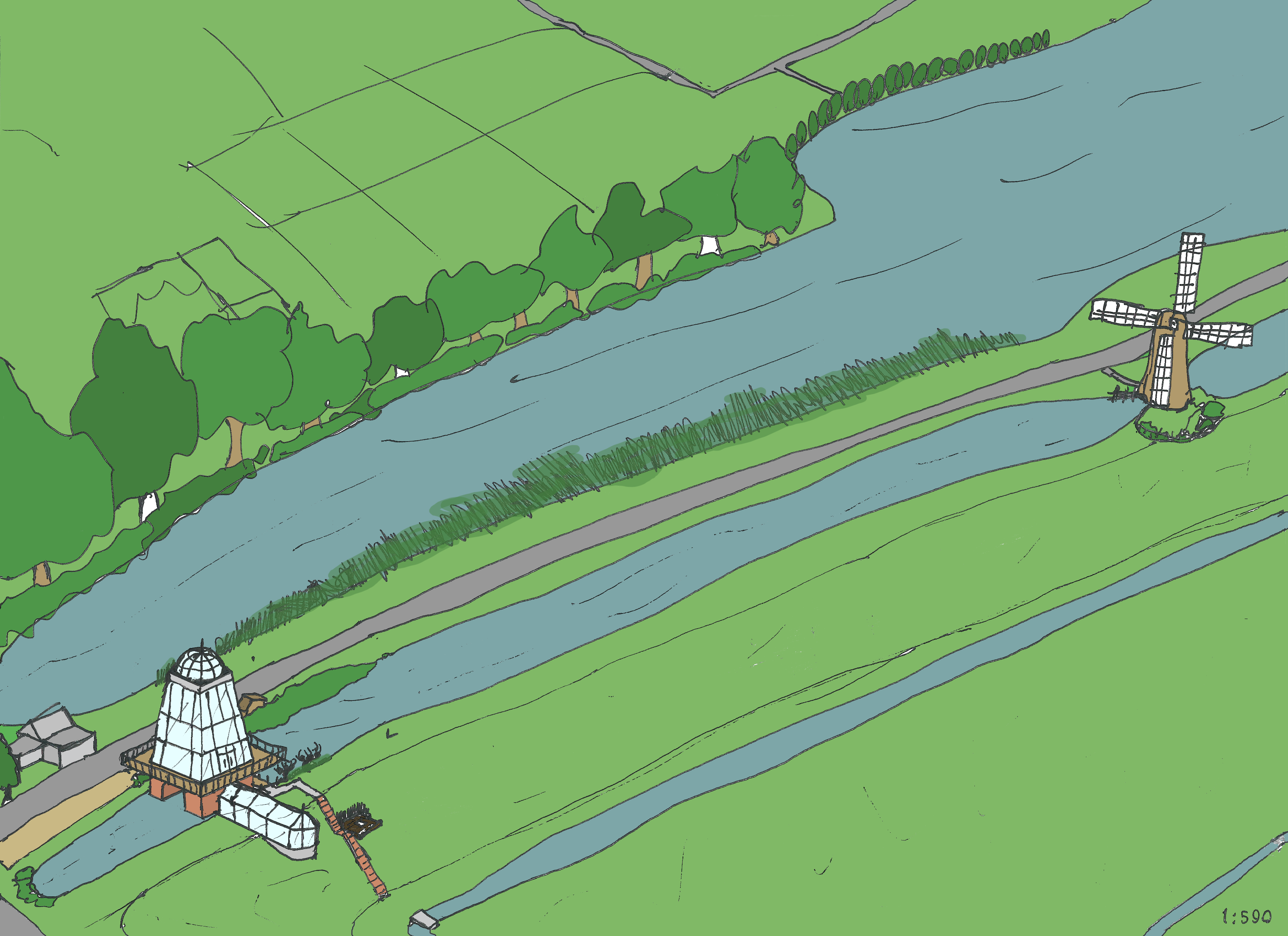
Isometric drawing of the building set in the surrounding landscape

Isometric drawing of the building set in the surrounding landscape
Anchoring in the Landscape
As described earlier, the site is located in the corner between to elements of a dike-system in a Dutch polder landscape. Along one of the dikes is a fast-traffic, 2-lane provincial road running between the towns of Leidschendam and Alphen a/d Rijn. The road runs over the top of the dike, which provides great views from (relative) altitude over an otherwise flat landscape. Along the road there are multiple farms which sit beside the dike and have driveways leading up to the main road.
At the site, this road intersects with another element of the area's dike-system. Here, a partly paved road runs parallel to a wide stretch of water lined with vegetation on one side, and a narrower stretch of water marked by a series of three classical, Dutch windmills. This side road slowly descends into the polder, but dead-ends at the last windmill. It would be more apt to describe the windmills as 'ascending from the polder', as their purpose was to pump water from the polder into the 'boezem' (culvert), which runs next to the large provincial road.
Within the assignment, there was relative freedom for choosing the specific site for the project. I choose to put the building right in the middle of the water at the top of the dike, at the intersection of the dikes/roads and in line with the existing windmills. These choices were made for the sake of connection to the landscape's history, view of and from the building, accessibility, and historical significance respectively. As such, the building gets to stand out as a strong, monumental statement to the landscape which it aims to celebrate, while still being in harmony with all that surrounds it.
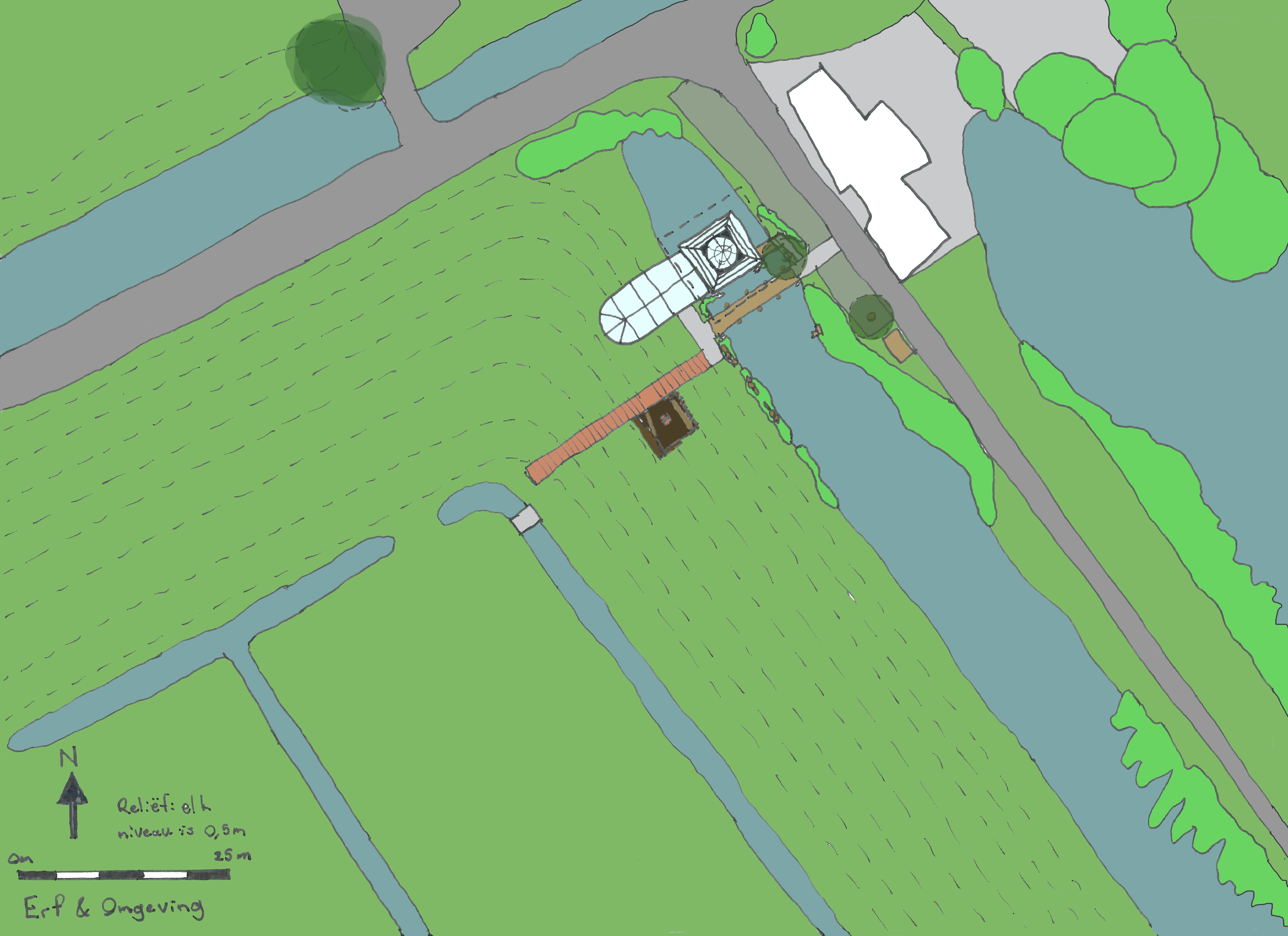
Plan of the site and surrounding context

Plan of the site and surrounding context
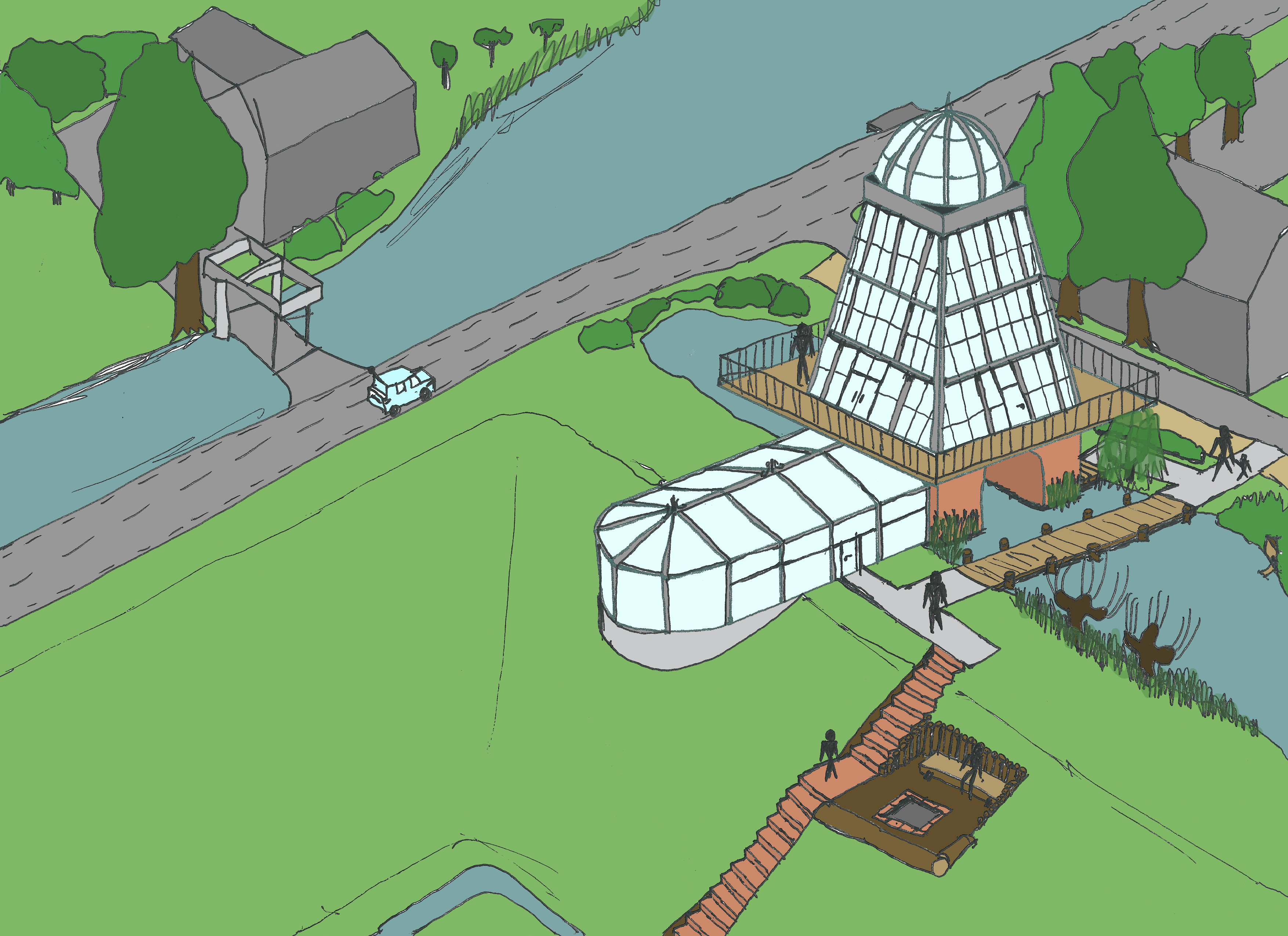
Isometric drawing of the building and site

Isometric drawing of the building and site
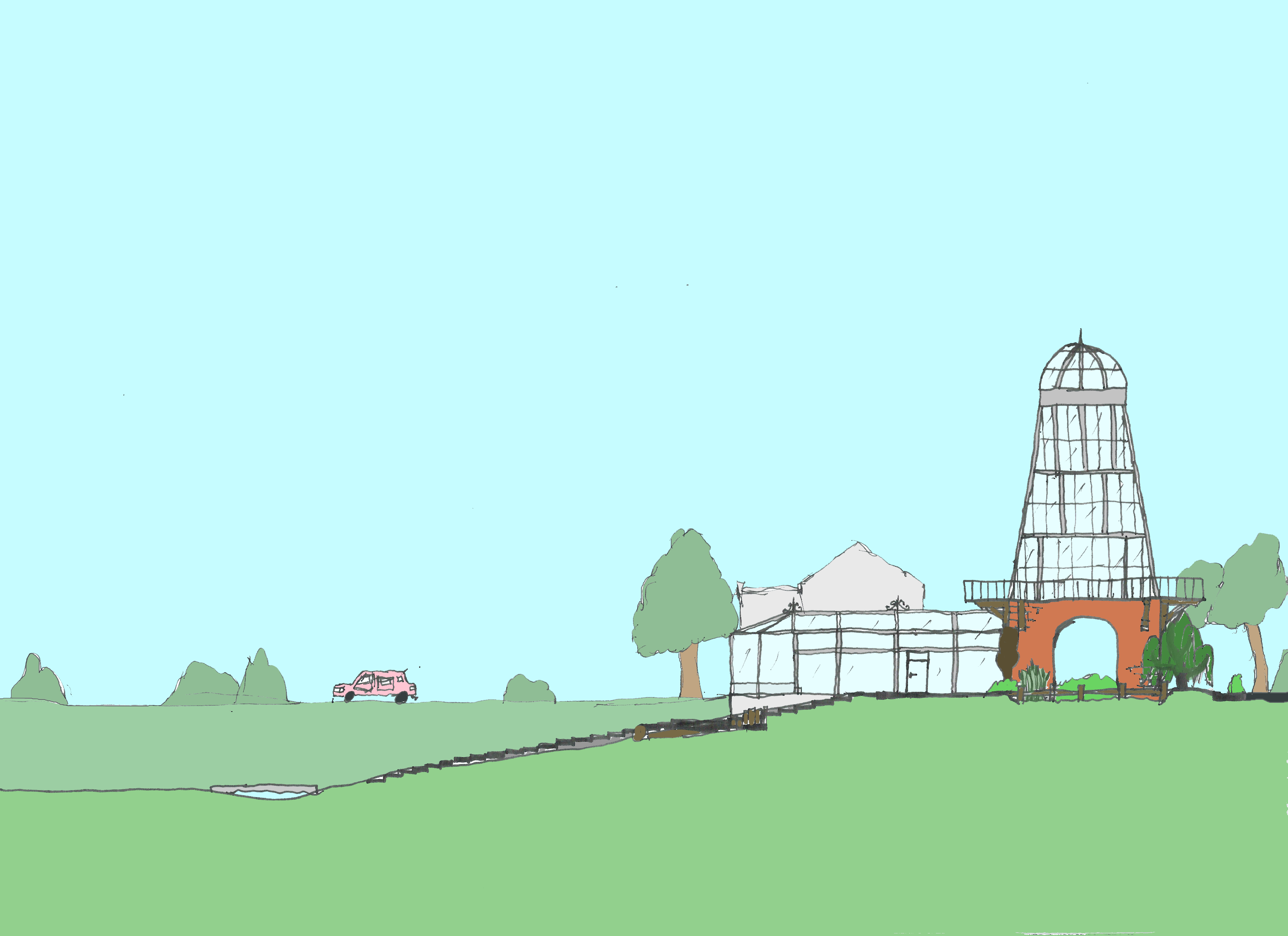
Section through the building, site and landscape

Section through the building, site and landscape
Facades
The exterior of the building consists of two primary volumes: a large tower, and a horizontal greenhouse. The greenhouse is a steel and glass structure set on a concrete plinth which extends from the ground as the dike lowers into the adjacent polder. This is also where most of the public functions and events are hosted. The tower, on the other hand, is where the park ranger's residence is located. It sits on an arched brick base which rises out of the water. Ringed by a wooden wrap-around balcony, the steel and glass tower continues upward, while slanting slightly inward, and is capped by a dome. The juxtaposition of the natures of the two volumes distinguishes the privacy of the residence from the public access to the park and educational center.

Northwestern Facade

Northwestern Facade
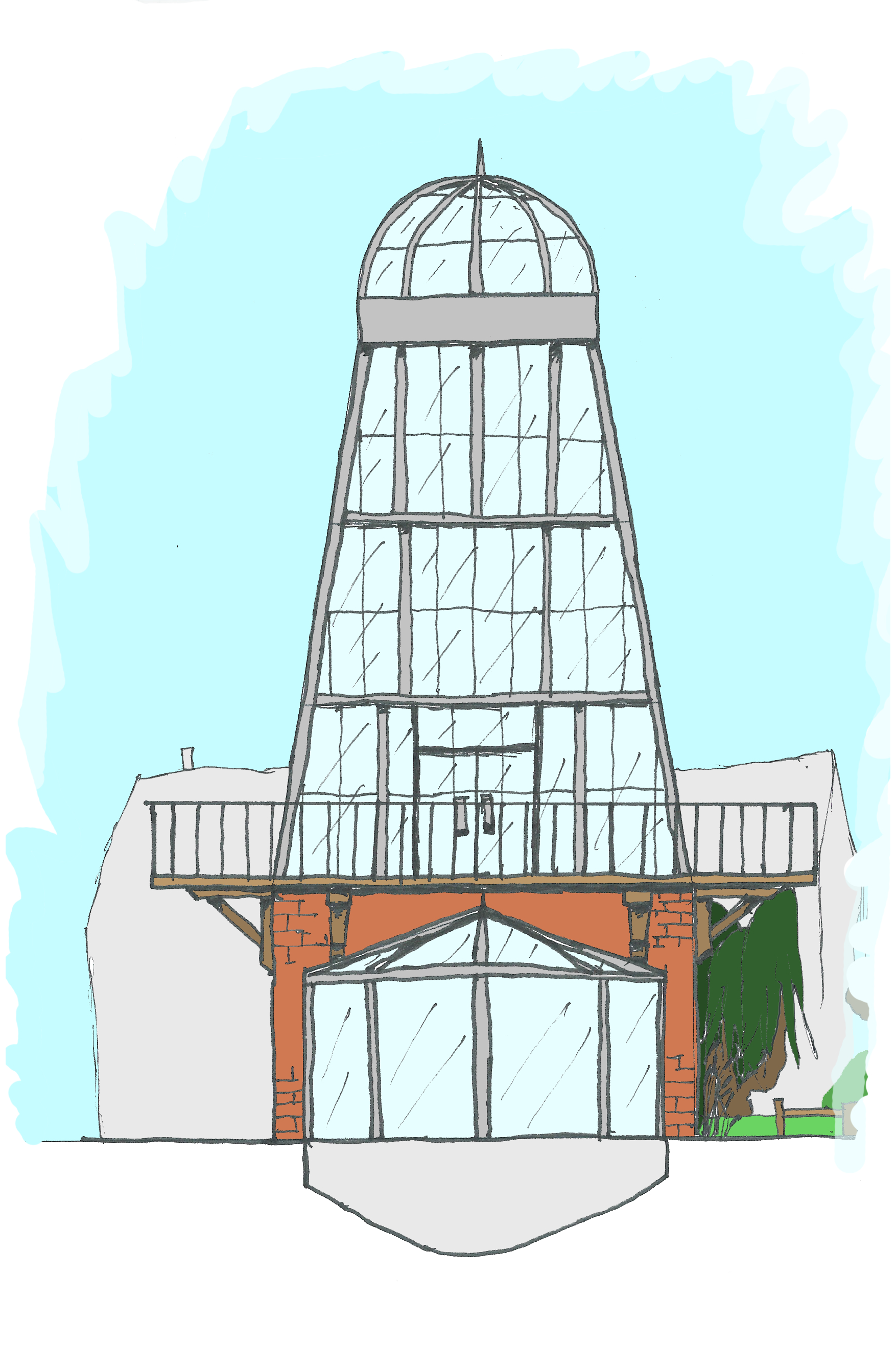
Southwestern Facade

Southwestern Facade
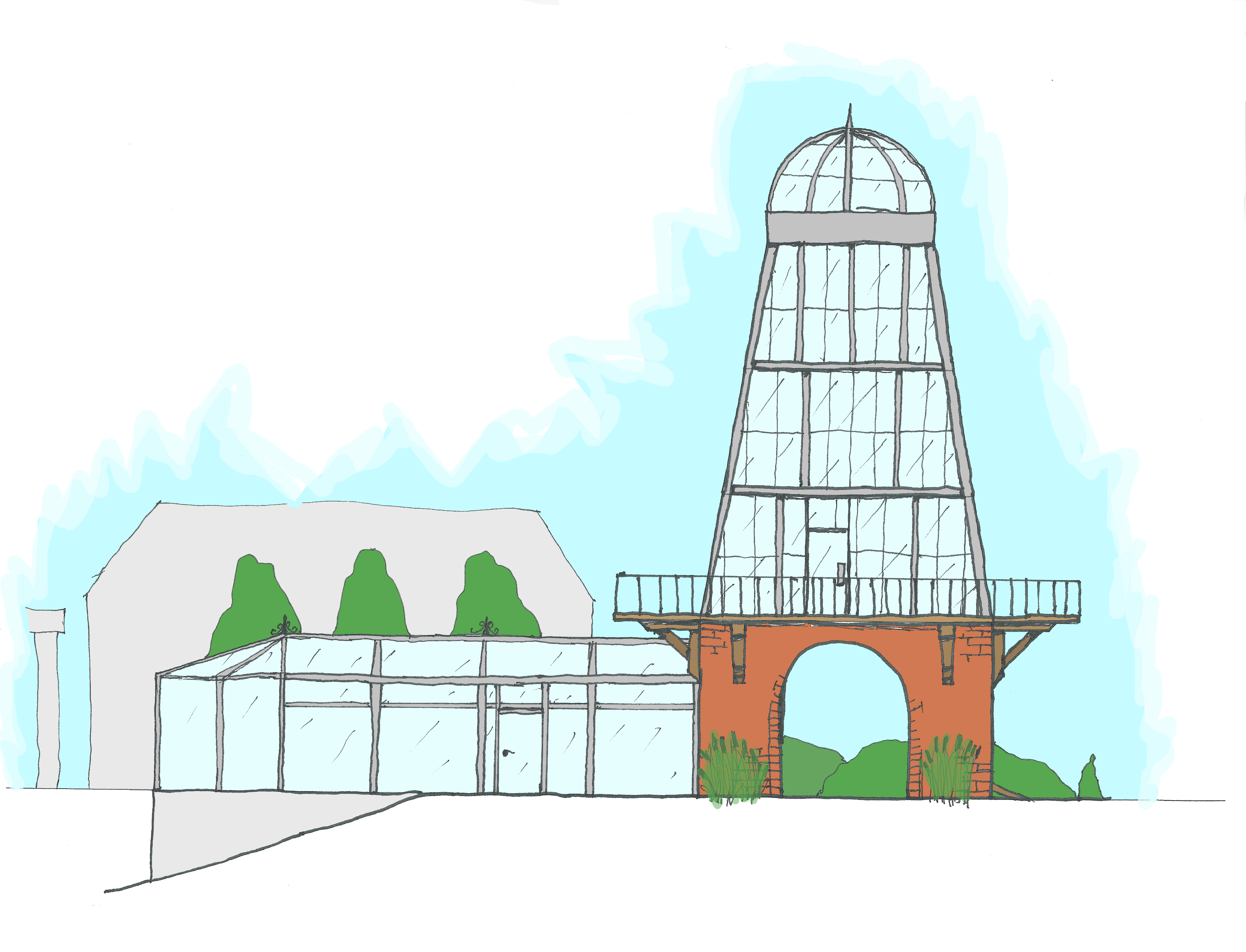
Southeastern Facade

Southeastern Facade
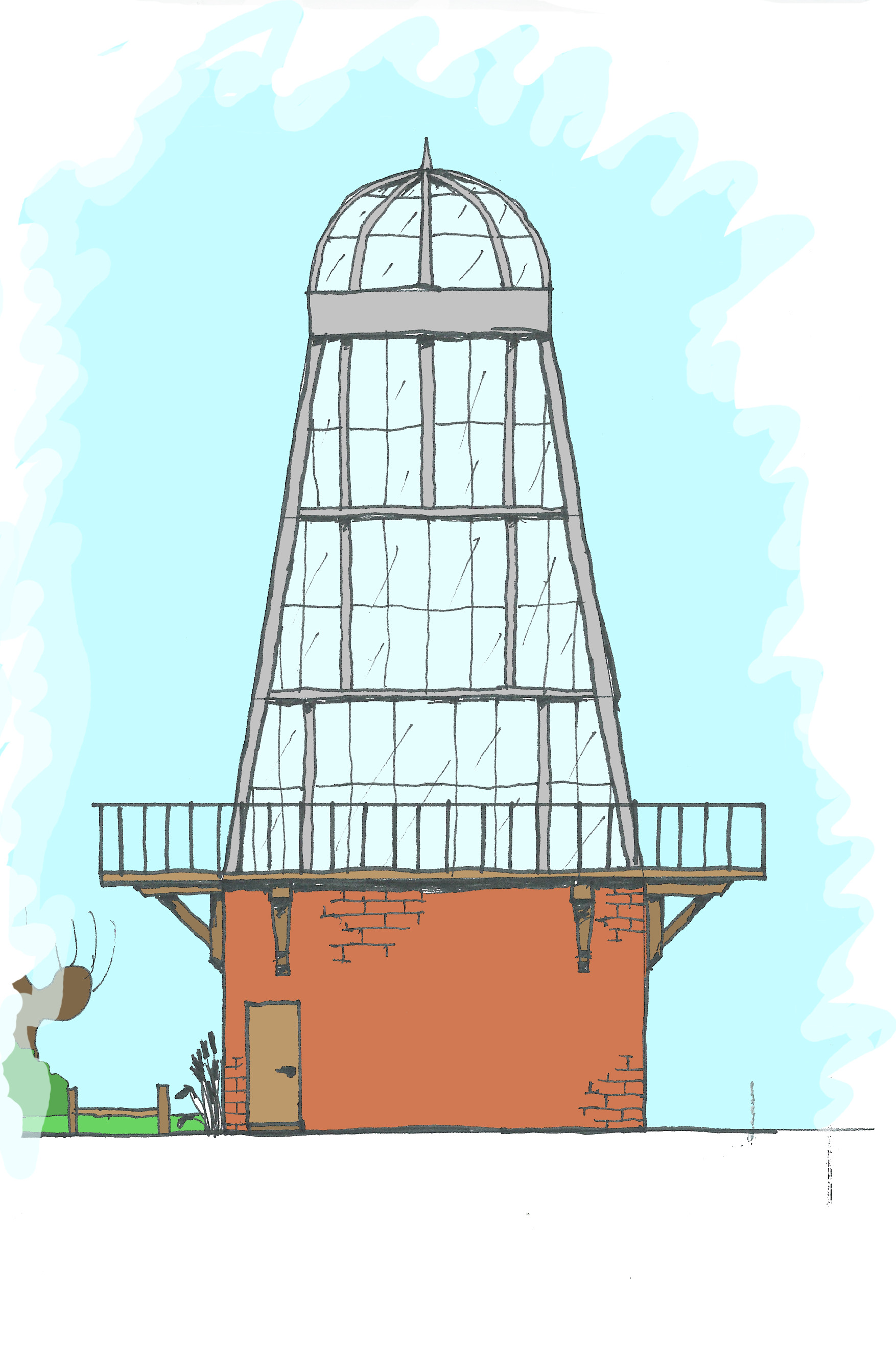
Northeastern Facade

Northeastern Facade
Impressions
This is a series of impressions I drew for the final presentation of the project.
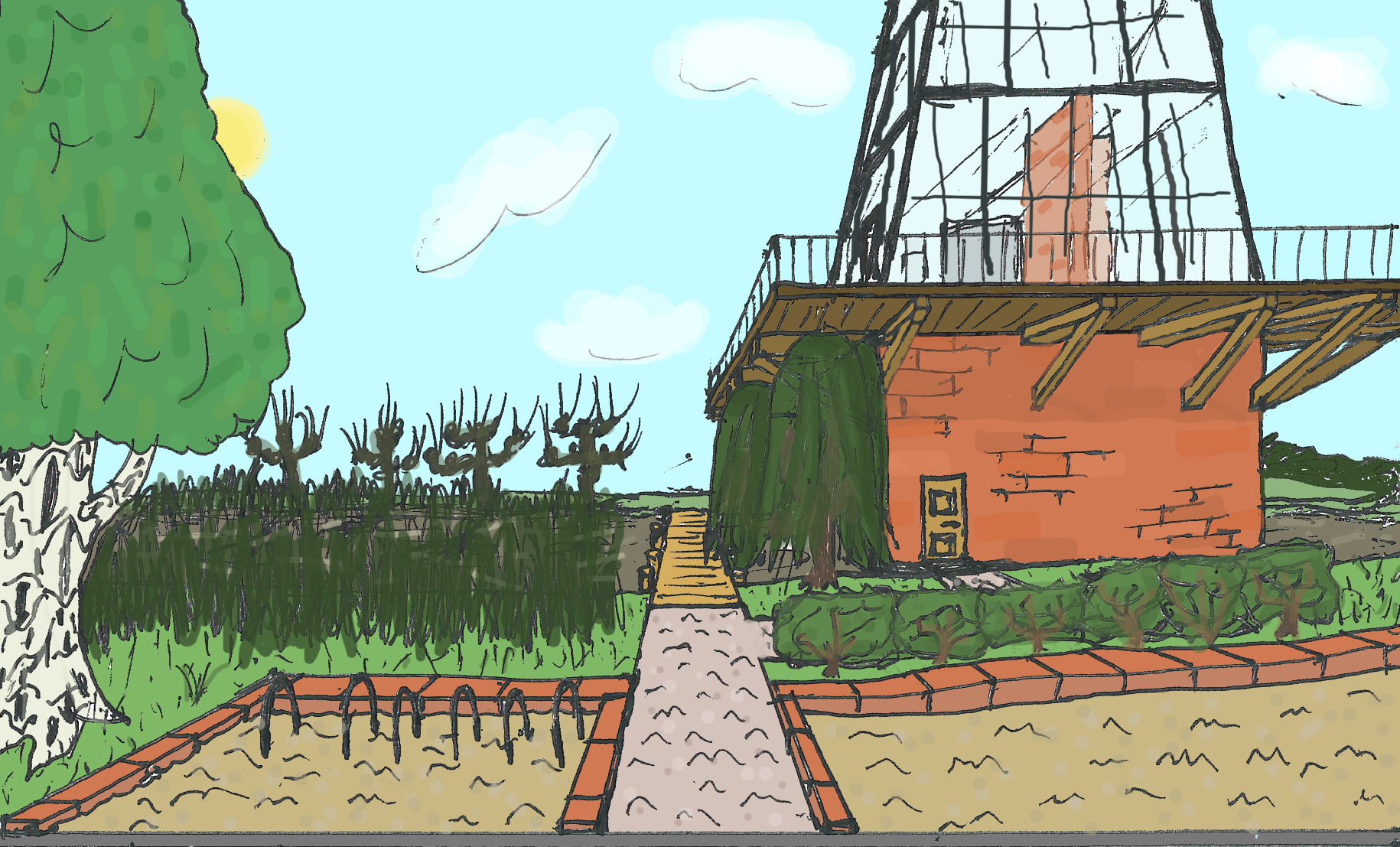
Entrance to the park and the building
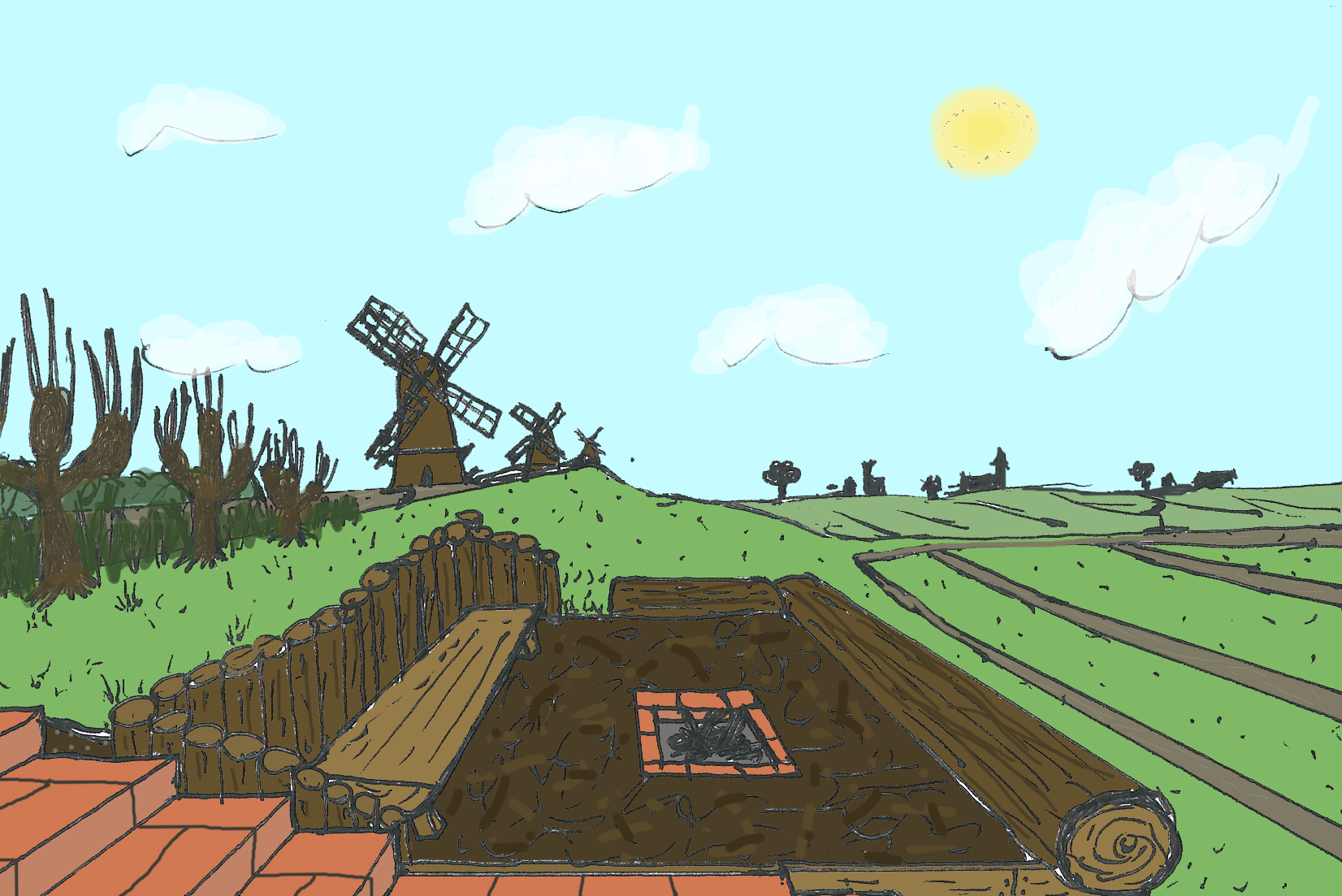
Fire pit integrated into terrain
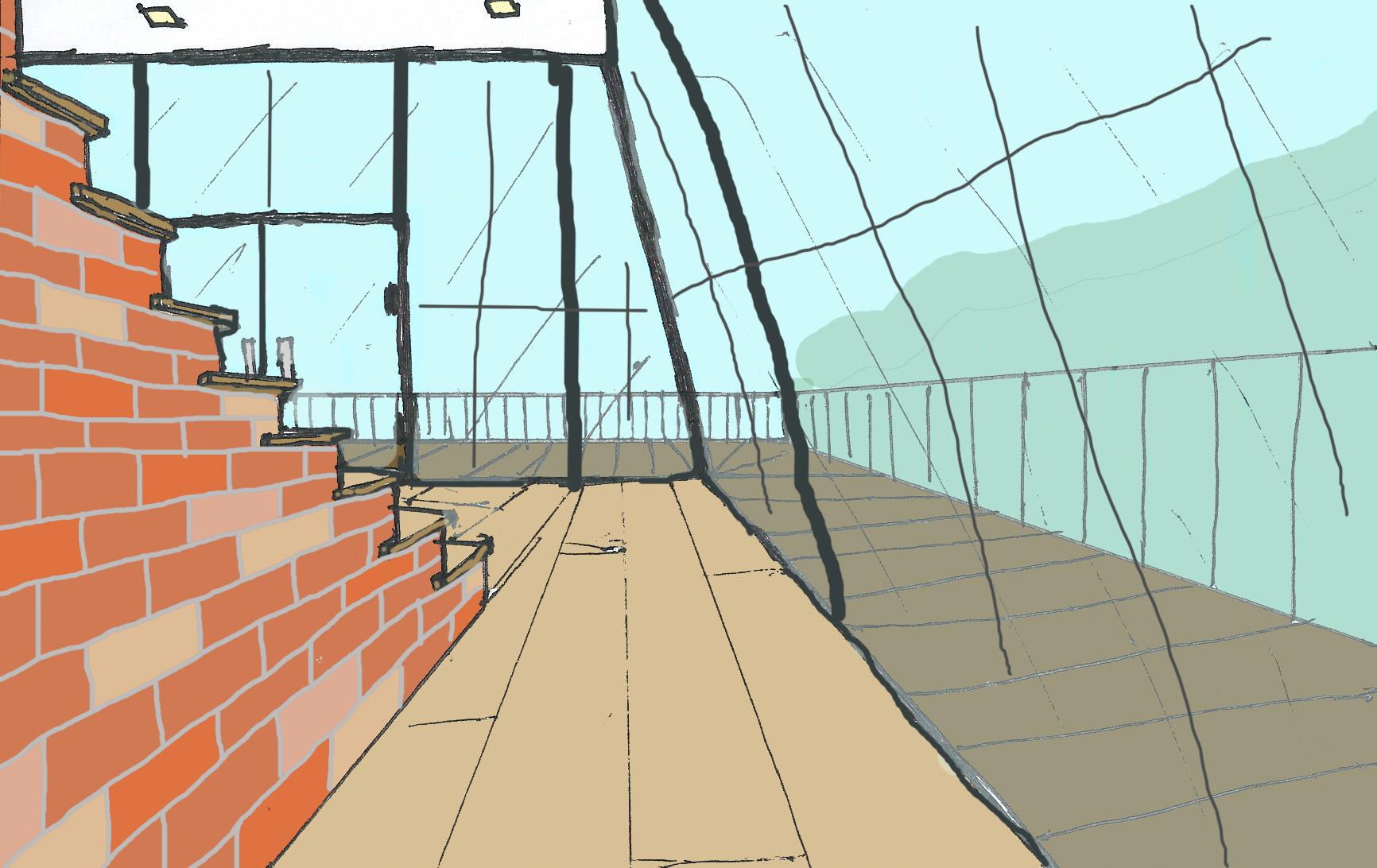
Entrance to private residence

Living room
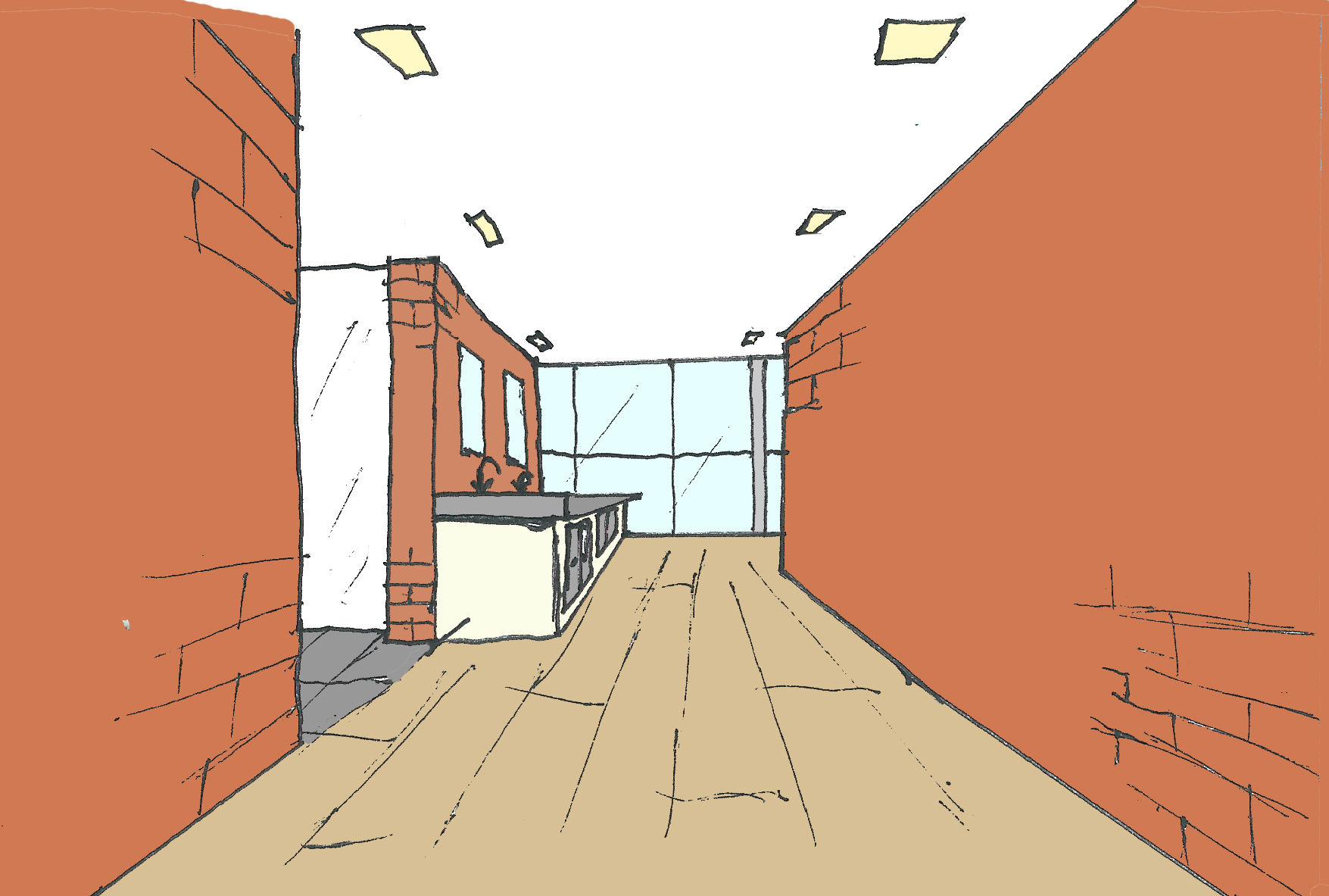
Bathroom
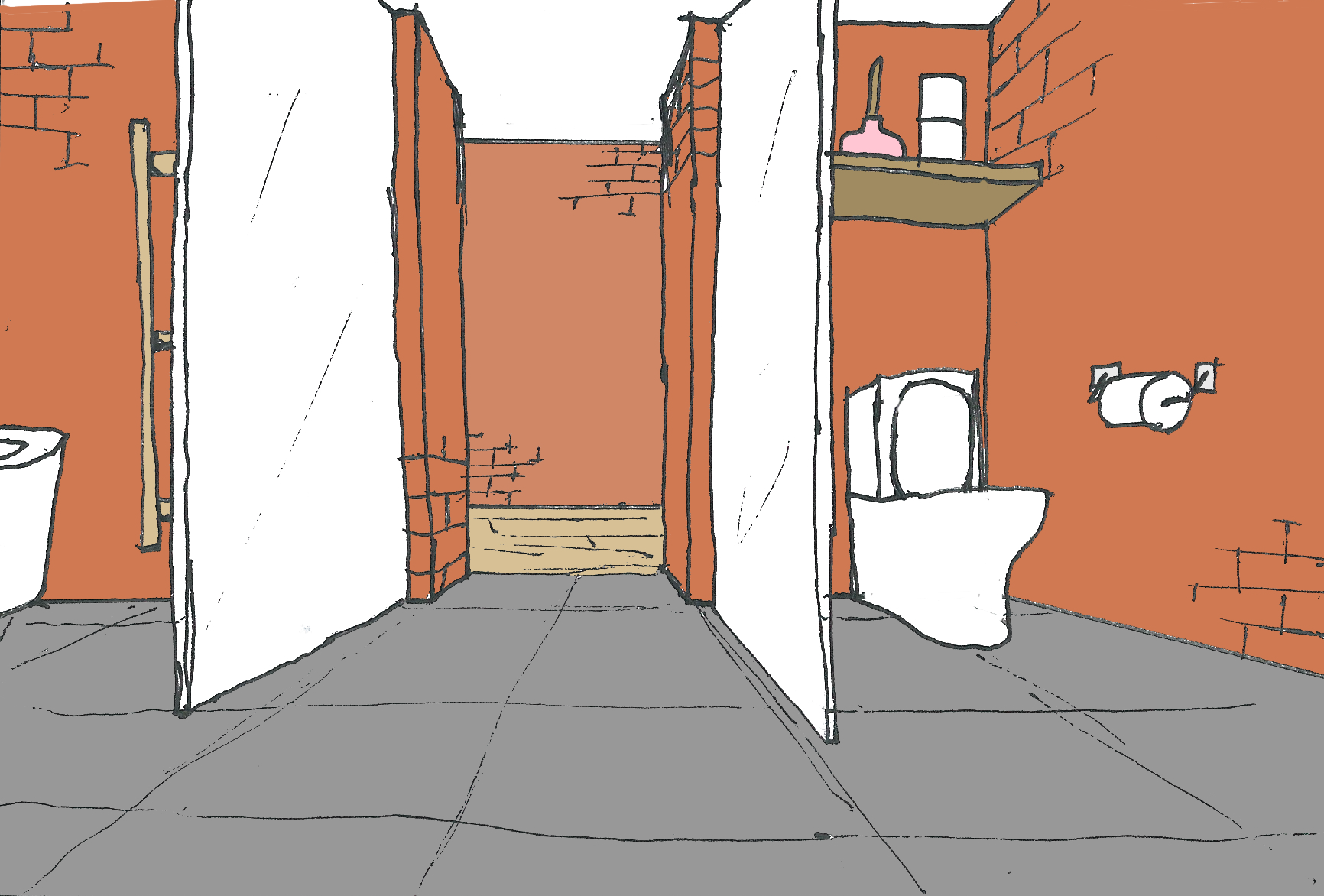
Toilet and shower
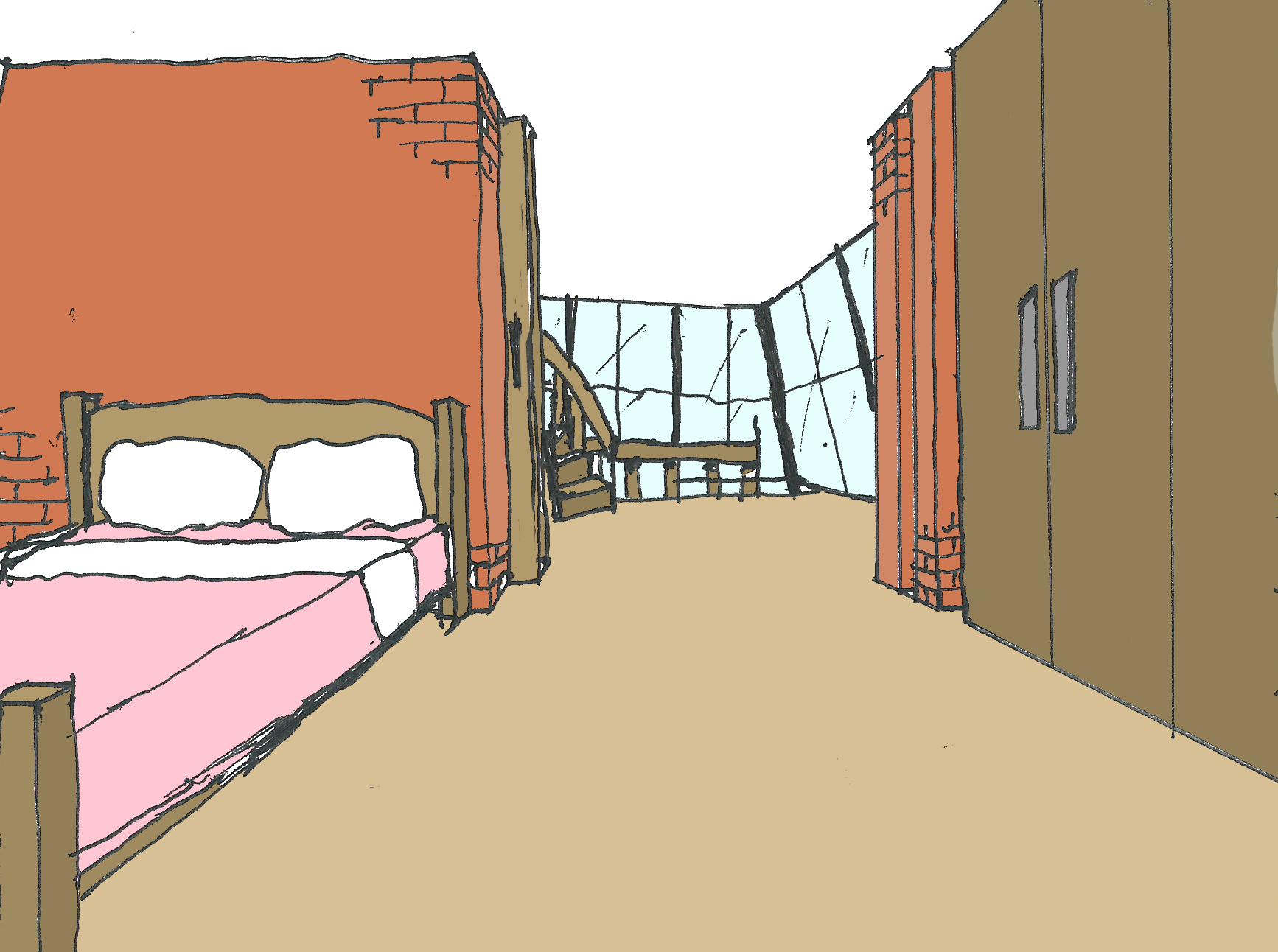
Master bedroom
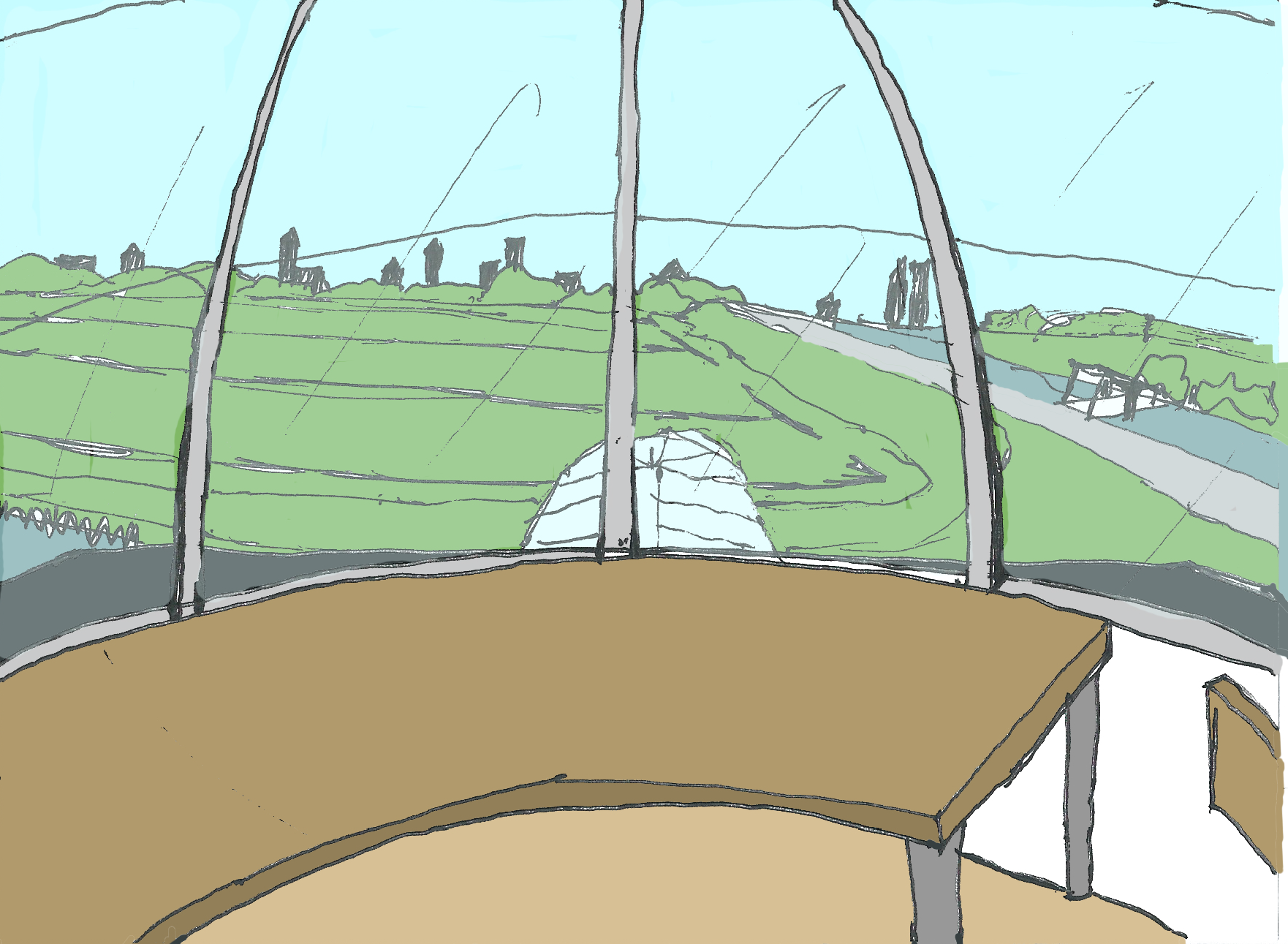
Office and lookout tower
Floor plans
Fourth Floor
This level contains the main office of the park ranger, which acts like a crow's nest. It is located inside a glass dome, providing full, 360-degree views of the surrounding area. The room features a wrap-around desk which functions as a workspace.
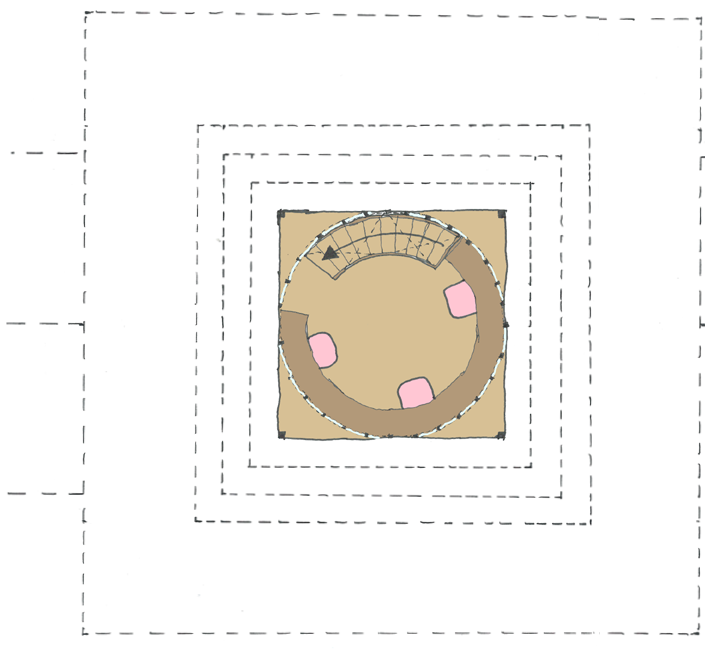
Third Floor
The third floor houses the master bedroom, as well as built-in closet space. In the event of family expansion it is possible to convert part of this floor to a second, smaller bedroom through the use of a sliding wall. This also provides the ability for the park ranger and spouse to seek privacy when one is working or trying to sleep.
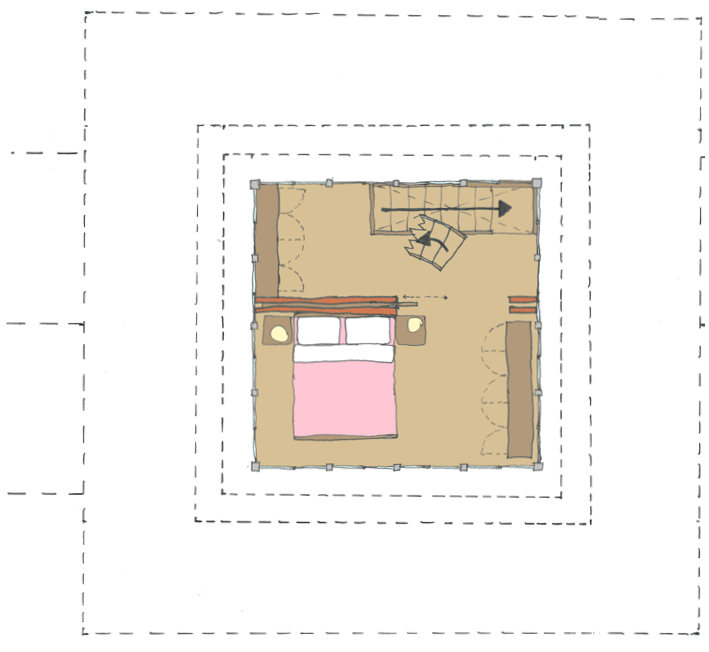
Second Floor
The second floor is the bathroom floor. It contains two separate sinks (each with a mirror and drawer space), a toilet, and a shower. The shower and toilet face the glass facade, allowing stunning views, but to prevent people looking in, the glass is coated with reflective foil. This floor also houses a dryer/washer and general storage space.
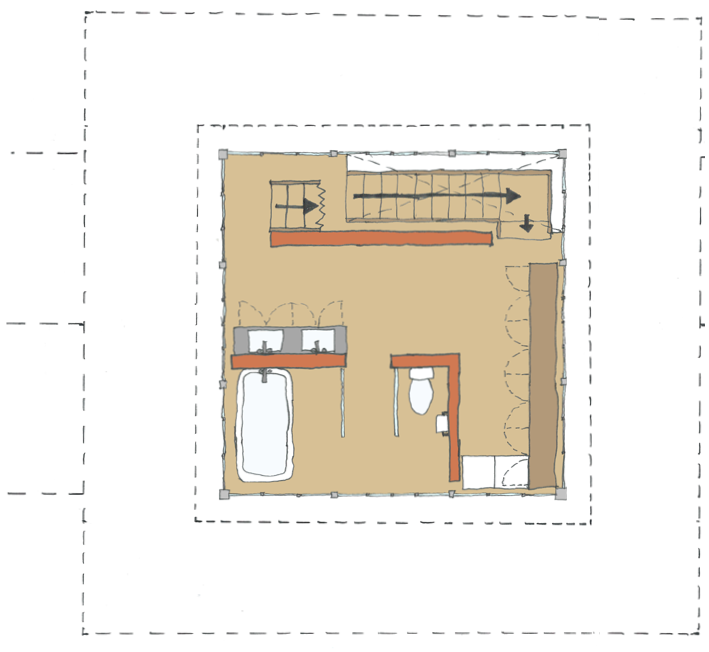
First Floor
This is the main living space within the residence. The floor contains the main living room, and an open kitchen. A small dining area joins the space, and is positioned for an optimal view of the surroundings. The space is complemented by a wrap-around deck, which makes the space feel more boundless and provides a space for outdoor activity in the summer months.
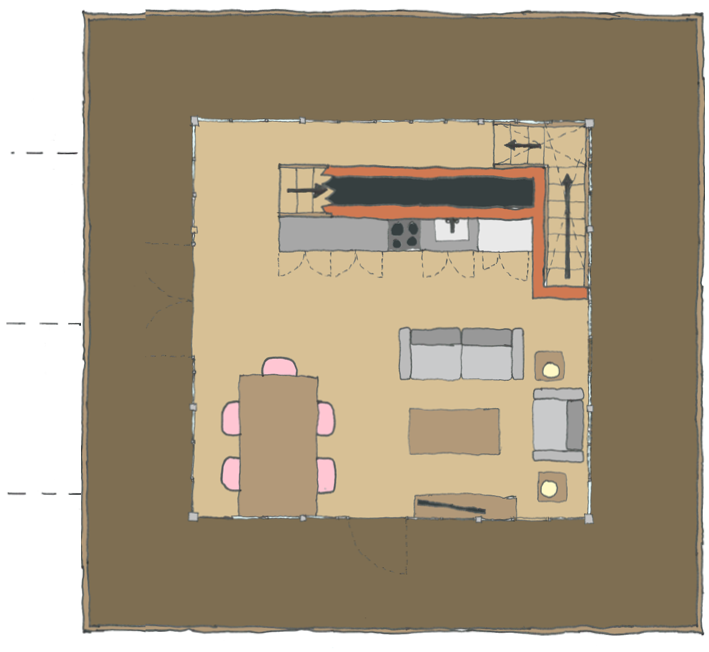

Floor plan for the Fourth Floor

Floor plan for the Third Floor

Floor plan for the Second Floor

Floor plan for the First Floor
Ground Floor
The ground floor holds the entrance to the residence (right) and is separated from the public visitor's center on the left. The residence is reached by crossing a small bridge and going through a locked door. The visitor's center on the other hand, is reached on the other side of the water, and faces the expanse of the polder nearby. The center is a large glass solarium, with flexible interior arrangements to host a variety of events. There is a bathroom and sink available.
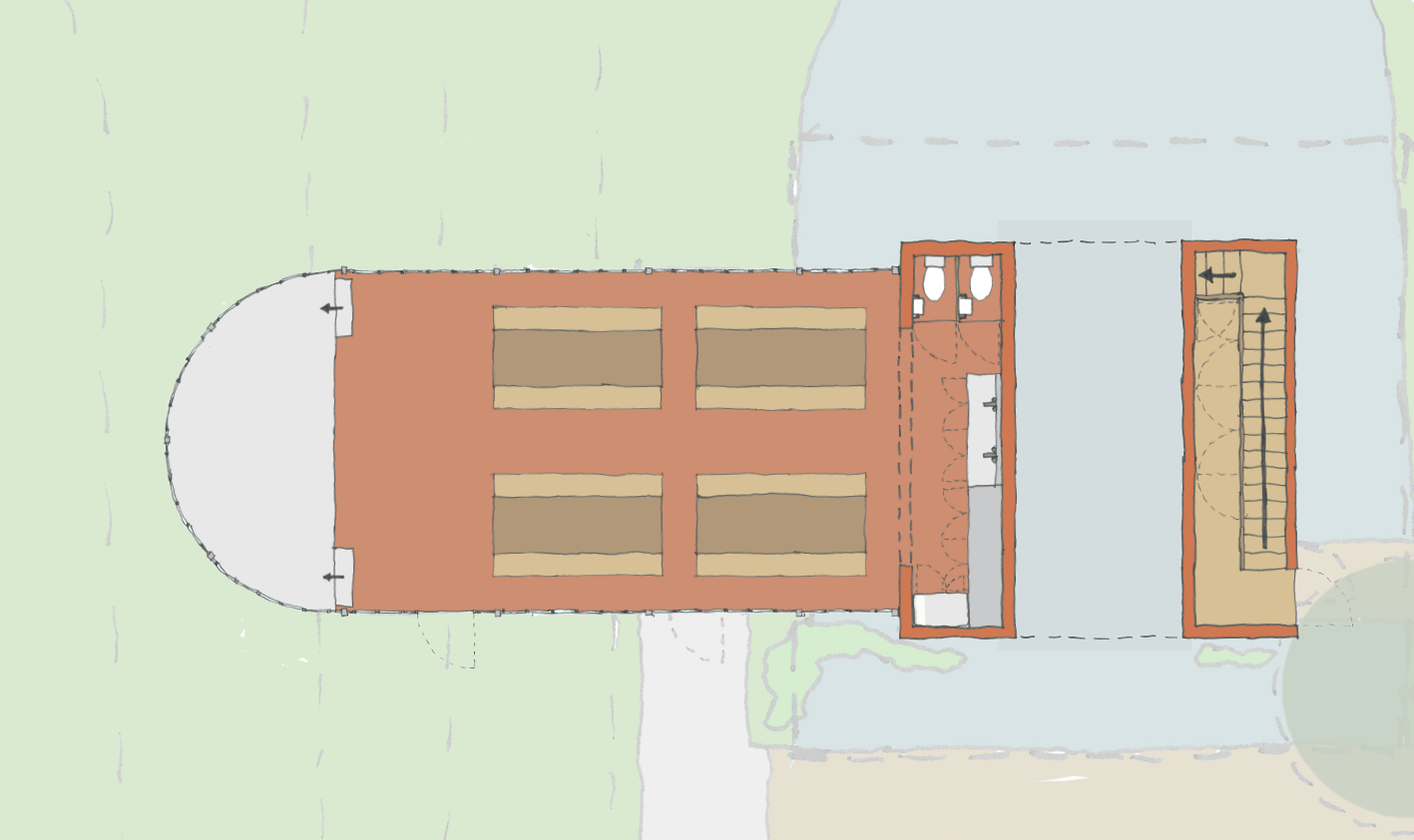

Floor plan for the Ground Floor

Impression of the parking area and entry to the park, lined with local vegetation

Impression of the parking area and entry to the park, lined with local vegetation
Grounds & Garden
In addition to the building, the assignment included designing a garden, and connections to the surrounding landscape. This includes spaces for parking, both cars and bicycles, creating walkways for visitors to walk through, access points for guided tours, and any relevant 'attractions'. My design features a minimal wooden walkway over the water, and walkways made of woodchips to create a more immersive experience, where one can feel the relative sogginess and instability of the land as one walks. To complement the design, vegetation suited to the area and promoting biodiversity are included. This includes cattails and reeds along the water, as well as rows of pollard willows, a majestic weeping willow and a birch tree by the entrance, and holly bushes around the parking area.
Other projects
Read more about related projects, or return to the project overview.
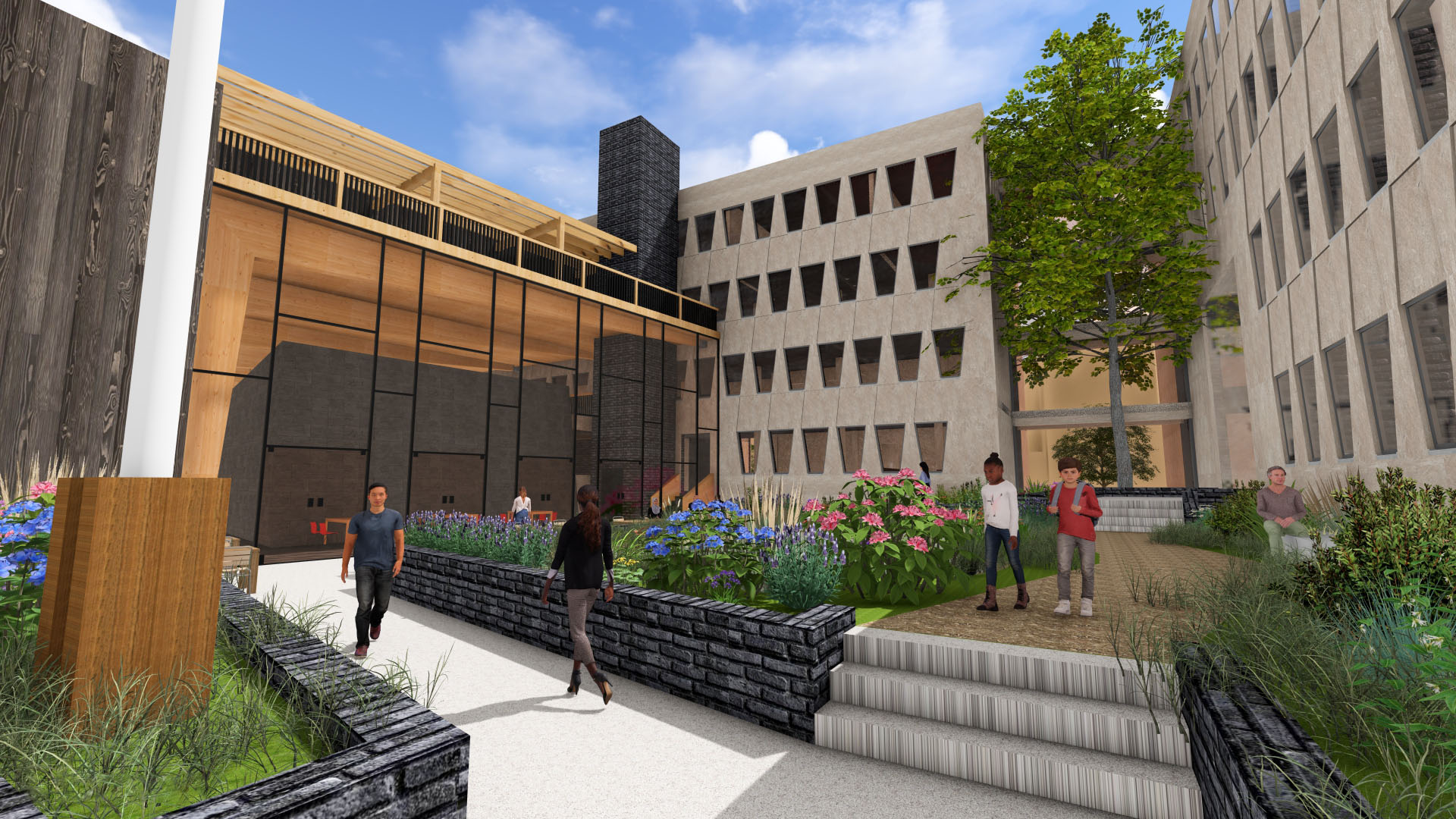
Most recent project
Tying Up Loose Ends >>
This redesign of the former United States Embassy to the Netherlands, located in the Hague, is all about blending existing values with new applications.

DuDock House >>
A passenger terminal for automated RoBoats. Includes a small museum for the concept, as well as the main RoBoat workshop and traffic control.
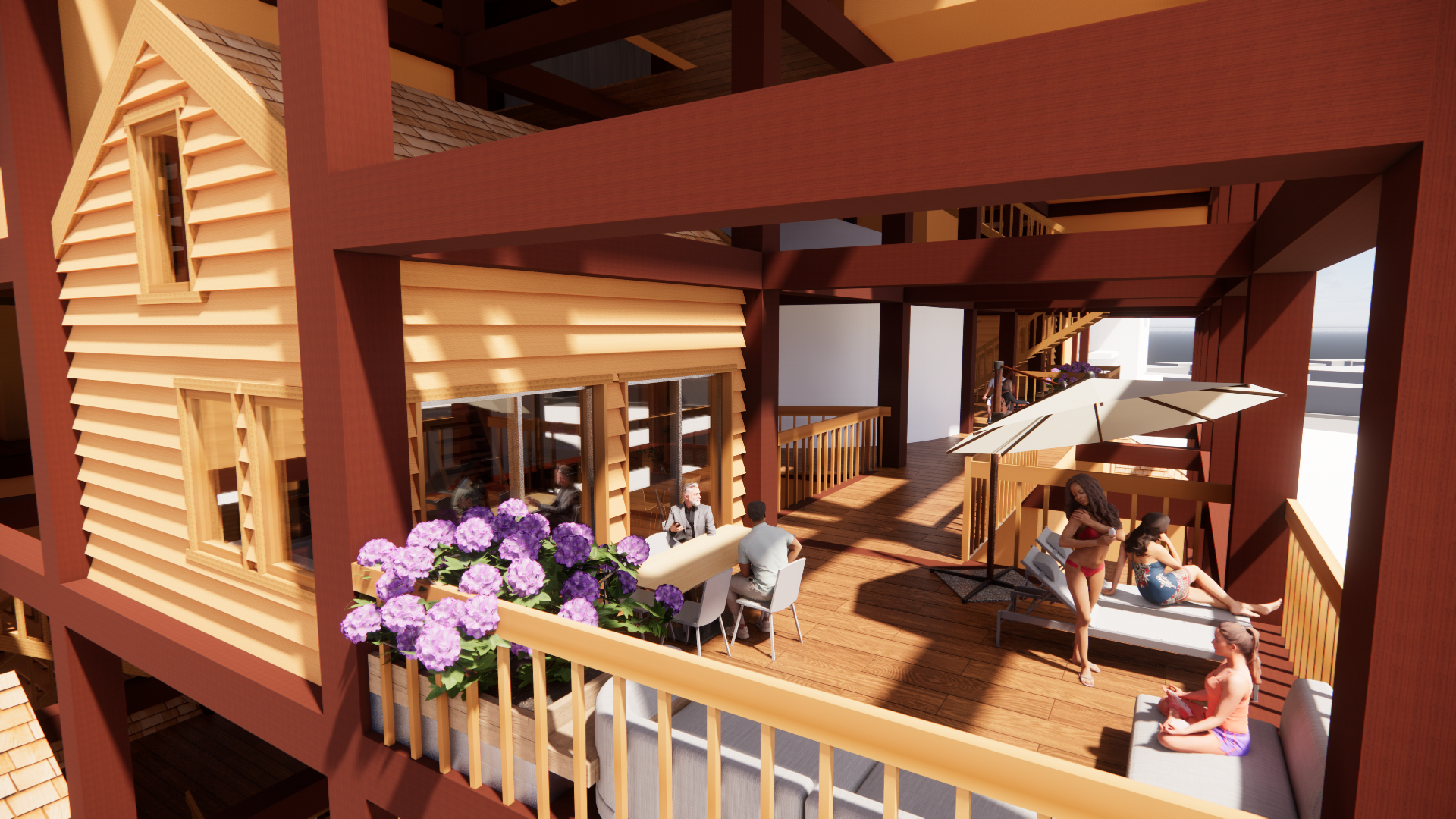
Treehousing >>
This large-scale housing project focuses on the essence of living: what is it that people want and need in their day-to-day lives? And how can values be incorporated into housing design?
